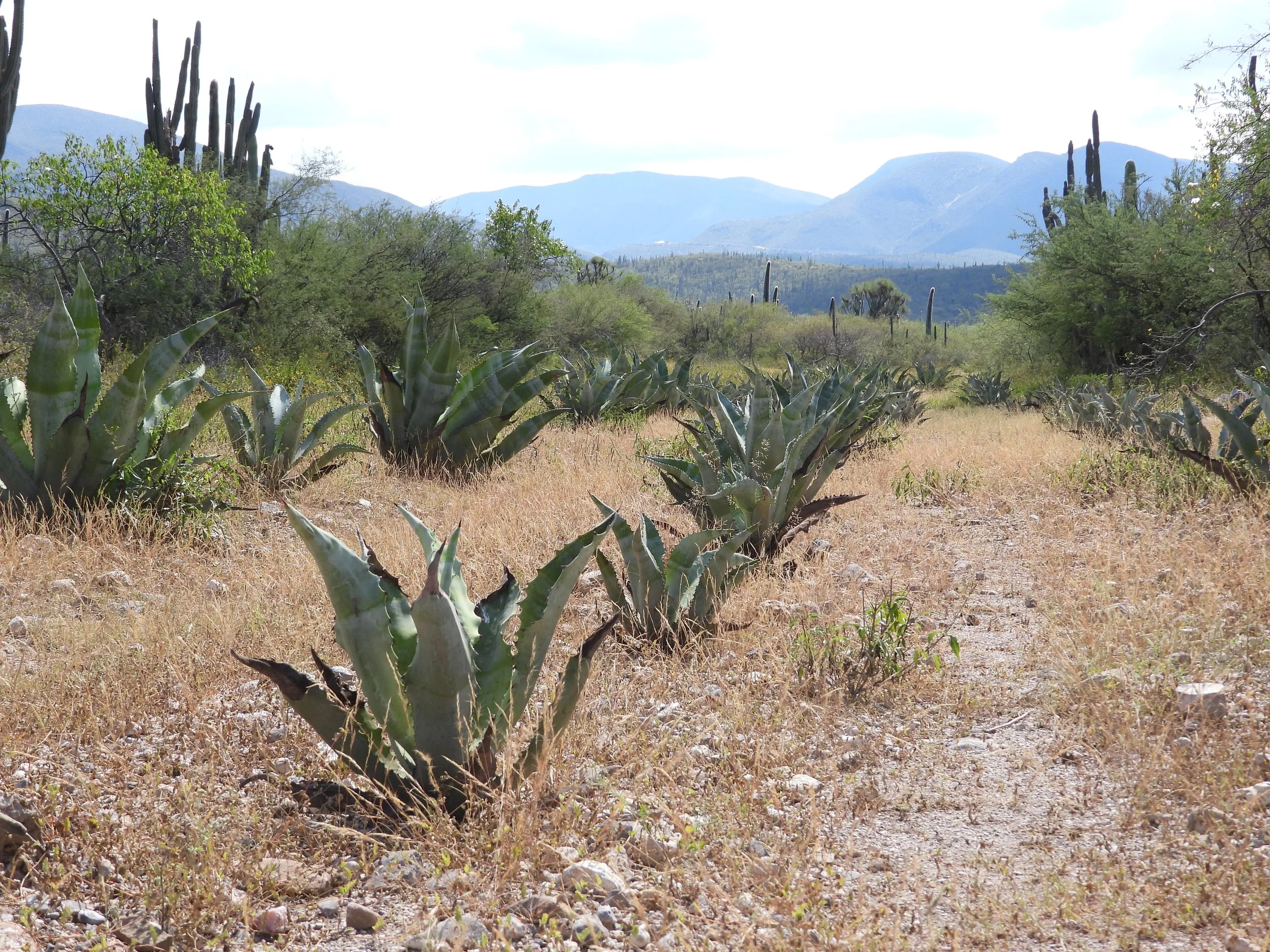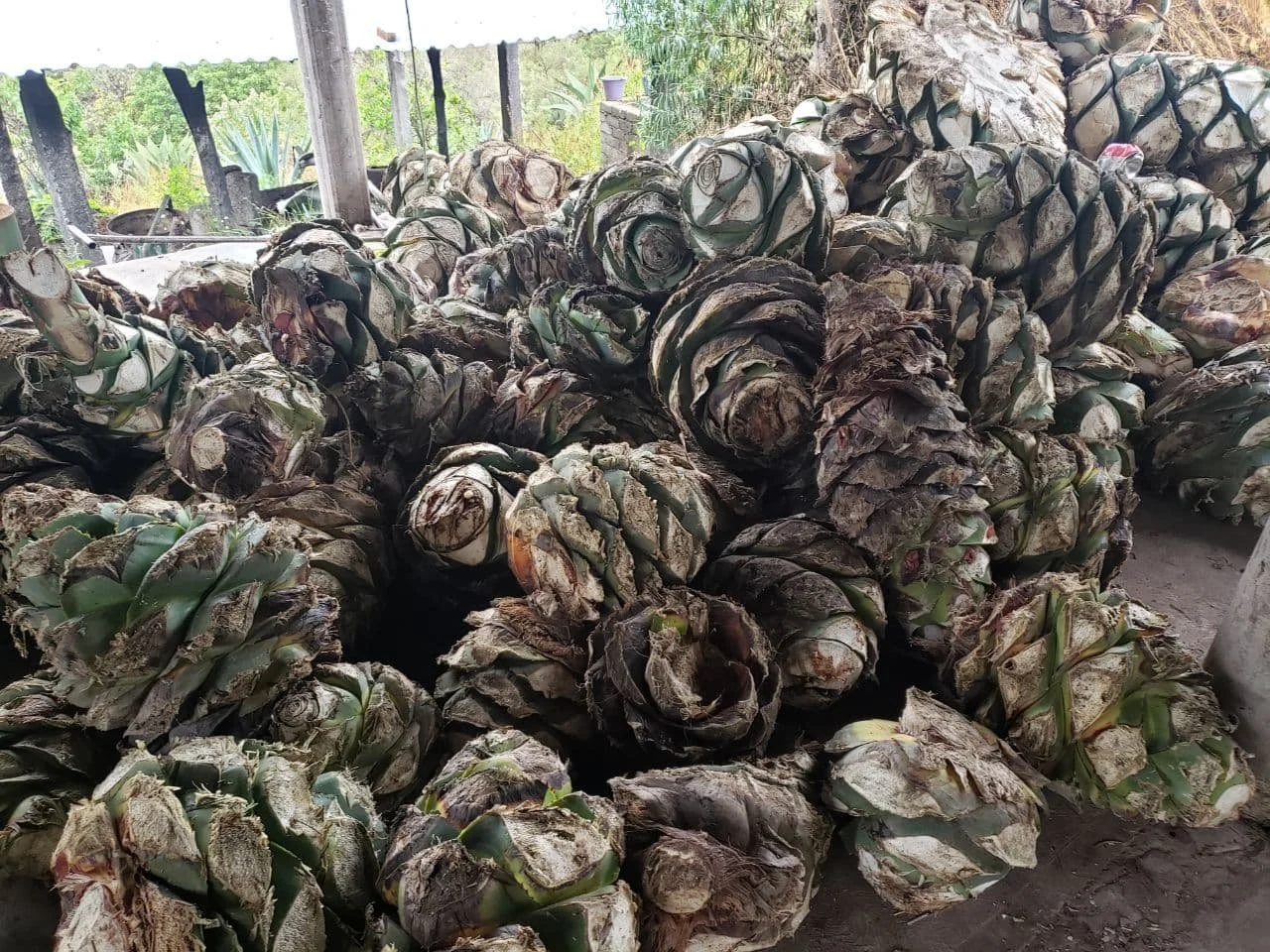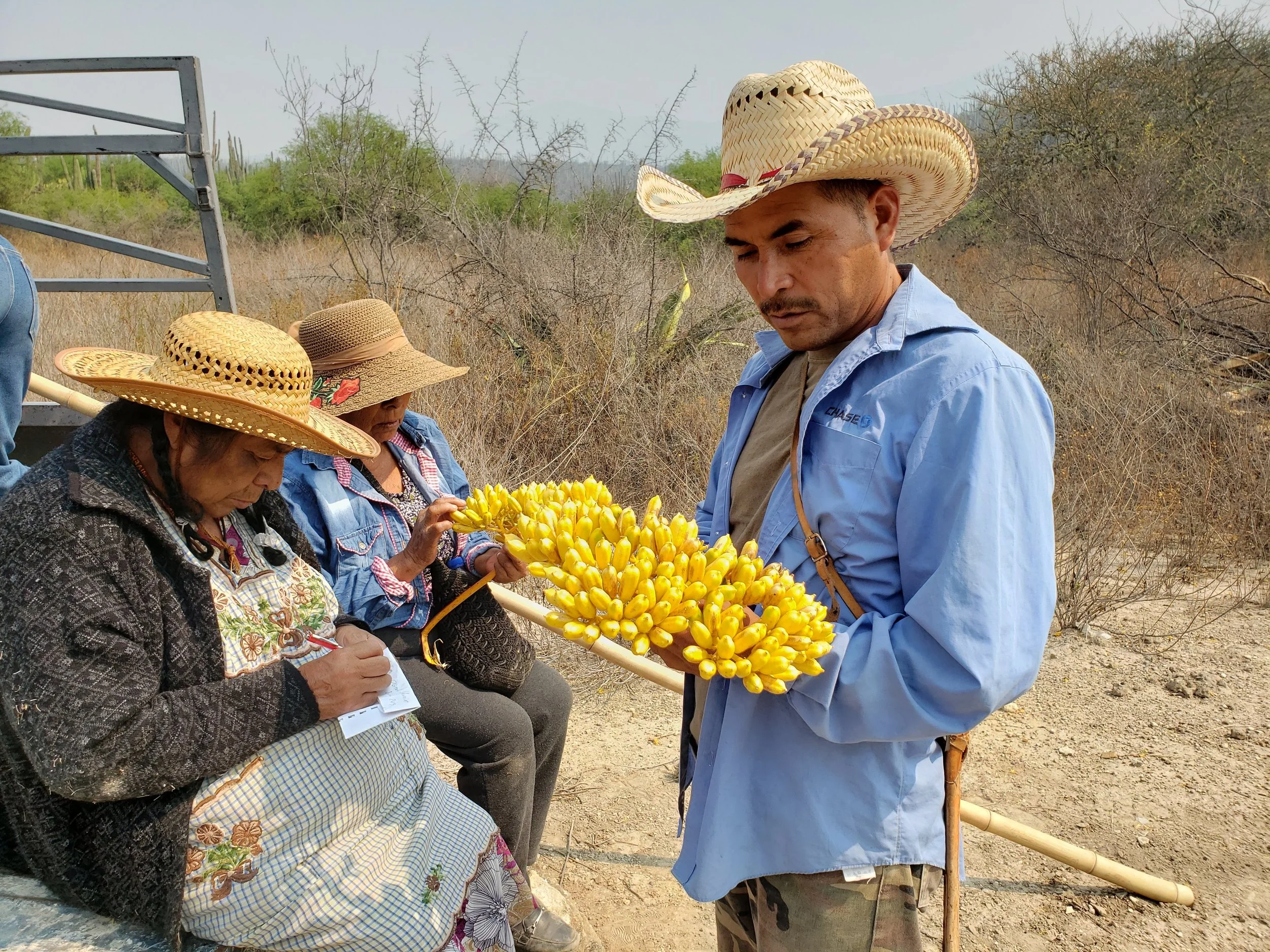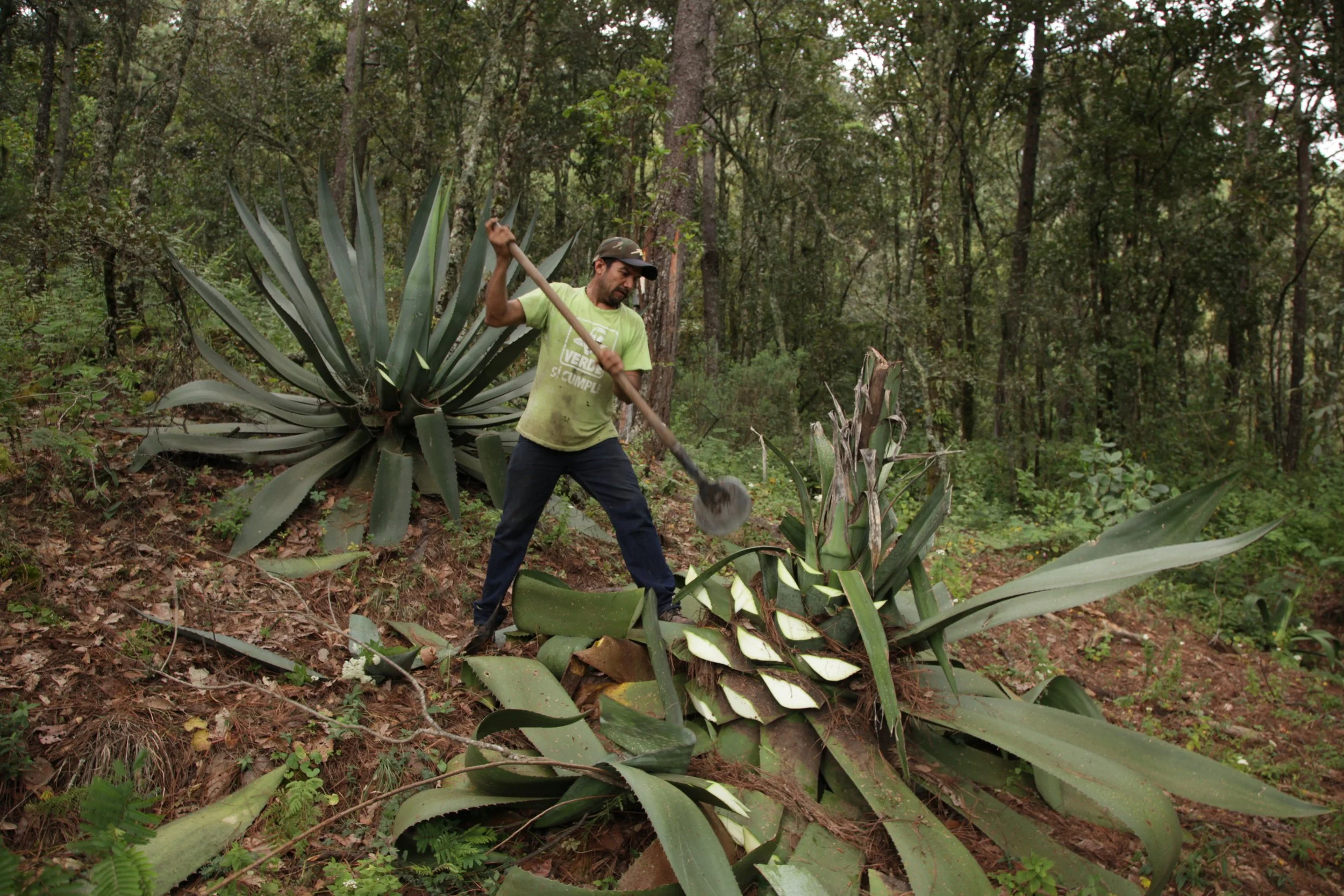Mezcal (Agave marmorata)
Agave marmorata.
by Carlos Lucio, Ignacio Torres-García and Fernando Reyes Flores
Background and history of use of Agave marmorata in the area
A. marmorata Roezl, is an endemic species of Mexico and is distributed in the states of Puebla and Oaxaca, in an altitude range that goes from 550 to 2300 meters above sea level (García-Mendoza et al., 2019). It is frequently found on steep slopes, and in various types of vegetation, mainly in dry tropical forests, such as the Izotal dominated by Beaucarnea gracilis Lem. and Yucca periculosa Baker, and the Tetechera dominated by the columnar cactus Cephalocereus tetetzo (F.A.C. Weber ex J.M. Colut.) Diguet. It is a monocarpic, rosetophilous, acaulescent and succulent plant (Gentry, 1982). The size of the rosette can reach between 1.5 and 2.5 m in diameter, and it is made up of between 30 and 50 leaves, 1.2 m high. In the dry season it blooms and produces a massive inflorescence with intense orange-yellow flowers, which stand out among the dry vegetation. Its flowers, during the day, are a source of food for insects, mainly bumblebees and bees (Apidae), different species of hummingbirds and perching birds, especially birds of the Icterus genus (I. wagleri Sclaer, I. spurius Linnaeus, I. pustulatus Wagler, I. parisorum Bonaparte), who are the main pollinators; at night they are a food source for moths (Sphingidae) and bats, such as Choeronycteris mexicana Tschudi and Leptonycteris nivalis Saussure (Ornelas et al., 2002; Thiede 2020), both on the IUCN red list, as Near Threatened (NT) and Endangered (EN), respectively (Medellín, 2016; Solari, 2018).
Its various common names: pichomel, pitzomel, huiscole, becuela, tepeztate, maguey curandero reveal a long history of use as a fermented and distilled beverage, although the plant is also used for gastronomic, ornamental, medicinal, artisanal, fodder purposes and as construction material. Currently, its predominant use is as distilled beverage. It has traditionally been used in diversified subsistence strategies as a complement to the family economy, among other non-timber forest products. Until the middle of the last century its main use was for the production of pulque, and from the second half of the 20th century it began to be used for the production of mezcal.
The commercial boom of mezcal in recent years, plus the incorporation of the state of Puebla in the Mezcal Denomination of Origin in 2015, have triggered the intensification of production and opened illegal extraction processes that put the population viability of this species at risk. To reverse this trend in 2017, the organization Sauane Katchu was established, with the aim of ecologically ordering its territories for the sustainable use of maguey and other natural resources through agroecological technologies. The objective is to reduce the pressure on wild agaves that are highly extracted for the production of mezcal, and to design and implement management and production strategies with an agroforestry vision (Moreno-Calles et al., 2021).
Conservation status
In the official Mexican standard dedicated to identifying and listing native species of flora and fauna in some category of risk (NOM-O59-SEMARNAT-2010), A. marmorata is not mentioned. However, in a recent evaluation of the IUCN red list on Agave species (Torres-García et al., 2021), despite the fact that A. marmorata is classified as Least Concern (LC), it is reported a decreasing population trend in different subpopulations, especially in its northern distribution, in the state of Puebla. In this evaluation, the mezcal industry is pointed out as the main threat to its conservation, due to the constant and growing extraction of wild individuals (García-Mendoza et al., 2019). Habitat loss due to land use change, devastation of conserved forests to commercial agave plantations, also caused by the mezcal industry (MILPA, 2020), is registered, even if a large part of its distribution is inside the Tehuacán-Cuicatlán Biosphere Reserve (RBTC).
In 2021, through field explorations, interviews and participatory workshops –in collaboration with the Environmental Transdisciplinary Studies Laboratory of ENES, UNAM, Morelia and MILPA AC– a diagnosis was made to characterize the patterns of intensification in the communities of Zapotitlán de las Salinas, San Juan Raya and San Luis Atolotitlán, in the Mixteca region of Puebla included in the RBTC polygon. Some significant findings of the risks derived from productive intensification were: the increase in extraction sites with traces of illegal looting of wild Agave marmorata. This is done mainly at night in around 19 wild areas, where between 30 and 80 individuals are extracted per day. This illegal activity is carried out in the territory of the communities of Zapotitlán de las Salinas, San Martín del Valle and San Juan Raya (where the raw material is found) to supply the community of San Luis Atolotitlán and Santiago Coatepec (where the mezcal factories, known as palenques, are located). In this last community, the increase from 5 to 18 mezcal production units in the last two years was documented. The testimonies of the residents confirm that since 1950, the populations of A. marmorata has dramatically declined; due to the increase in mezcal activity, there are currently only 20% of the wild populations that existed in the past.
Agave marmorata for mezcal production.
Diversity of uses and management
About 10 different categories of use have been registered in the area, highlighting among them the use in cooking –the baked stems and foliar bases are consumed as a candy– in addition to the extraction of fresh sap, known as aguamiel, and once fermented, as an alcoholic beverage called pulque. Among the other uses, the elaboration of crafts stands out –with the stems of the inflorescence, nests for parakeets are made, that are then sold in the regional market. It is also used as a building material –the long straight stems of the inflorescence are used for rustic huts. Medicinal uses include making syrups with the leaves and sap to treat respiratory diseases. It is also used as living barriers and land delimitation –the plants are used to protect crops and to distinguish between properties. Ornamental, ceremonial and religious uses are documented, too –the inflorescences are used as ornamentation of churches in religious celebrations. Recently, its use has gained importance for the production of distilled beverages such as mezcal, for which the stems and foliar bases of the plant are used (Caballero et al. 1984-2020; Torres-García et al., 2019). This is the use that determines a constant and growing overharvesting –mostly illegal– related to a commercial activity that has recently reached global proportions (Torres-García et al., 2020).
In the RBTC, individuals are mainly extracted and used from wild populations and commercial plantations are currently being established for the production of distillates and other uses. However, in the Tehuacán Valley there is an old form of land use, a traditional agroforestry system for the cultivation of corn, that conserves about 40% of the native plant diversity, most of them useful, including Agave marmorata (Vallejo et al., 2015; Torres-García et al., 2019). The objective of the Sauane Katchu collective and the RBTC is to keep alive this traditional knowledge of land management and incorporate agroecological innovations within a comprehensive and responsible vision (Moreno-Calles et al., 2021).
Collection of mature Agave marmorata seeds by the Sauane Katchu collective.
Regulatory framework and intensification vectors
The increase in the patterns of intensification in the mezcal industry and the expansion of denominations of origin for agave distillates (tequila, mezcal, bacanora, raicilla), are producing changes and metabolic ruptures in various regions of Mexico, particularly in the Tehuacán Valley area, where the Tehuacán-Cuicatlán Biosphere Reserve is located, known as the floristic province with the greatest diversity of agave species in all of Mexico (García-Mendoza, 2007). The official quality standard for mezcal (NOM-070-SCFI-2016), establishes three categories of mezcal: "ancestral", "artisanal" and "mezcal" – which can be distinguished technologically as “traditional”, “artisanal” and “industrial” all categories allow the use of pit ovens for cooking the agaves, but, for example, to call it "ancestral", the distillation must be done in a clay pot/or wood –most valued by consumers due to the organoleptic complexity of this distillation technique (Hernández-López, 2018). This determines a substantial increase in the consumption of wild dendroenergetics and water for the mass production of mezcal, now directed mainly to the export market. By essentializing the technological dimension of the ancestral method in the official standard, a vector of intensification of traditional production technologies is produced, which triggers the metabolism of the two main inputs –firewood and water– especially with the use of oaks, mesquite and pine wood, in a proportion of 8 kg of firewood for every liter of mezcal (Palma et al., 2016; FAO, 1991). This means that during 2020, with a total production of 7.5 million liters, 60 thousand tons of firewood were consumed, often without complying with the regulatory framework related to sustainable forest use.
For the MILPA collective, we are interested in promoting strategies for prevention, restoration and mitigation of the socio-ecosystemic effects caused by agave distillates commercial boom, strengthening the alternative management of resources with agroecological and agroforestry perspectives, in addition to strengthening traditional ecological knowledge, through peasant-to-peasant methods, knowledge dialogue between academic communities and maguey producers and managers. Additionally, according to the scale of intervention at the plot level, we are interested in promoting the recognition of family work, and the role of women and youth in these alternative production models.
Transdisciplinary meeting in the field for the collection and selection of Agave marmorata seed. Selection of the best fruits.
Discussion
The RBTC area has become one of the main scenarios of the socio-environmental crisis related to the productive intensification of the mezcal industry (MILPA, 2020), since the incorporation of 115 Puebla municipalities to the DOM in 2015 and despite that most of these municipalities have no relationship with the mezcal tradition. The abundant diversity of agave species present in the Tehuacán Valley has triggered illegal extraction processes for commercial purposes and puts at risk the population viability, particularly of A. marmorata. In order to restore these processes of metabolic rift, community management strategies are being implemented to increase the population of wild agaves, with their reproduction in nurseries and establishment in different priority reforestation areas that strengthen traditional agroforestry systems.
The business model promoted by the denominations of origin for agave distillates converts common goods into capital, through declarations of protection of intellectual property that constitute a form of regulatory capture and exclude small producers who, for various reasons, cannot comply with the certification and regulation processes, in addition to the fact that it mainly favours the transnational marketing chains promoted by agents of global capital, at the expense of territories, ecosystems, cultures and ways of life. The regulatory change of the official quality standard for the production of mezcal NOM-070-SCFI-2016, has become one of the main vectors of productive intensification by promoting the folklorization of ancestral mezcal, paving the way for new agro-extractive dynamics that threaten a set of natural resources associated with the production chain, especially due to the high consumption of wood and water, whose intensive use is extremely problematic in the most diverse semi-arid areas of Mexico –incorporated in the UNESCO World Heritage list due to its biological and cultural diversity.
Agave marmorata seed counting and selection.
In short, the pressures generated by the international market for agave distillates require changes in the regulatory framework that disrupt and violate local and regional contexts, while appropriating the natural and human components that it supposedly seeks to protect through denominations of origin. From MILPA AC and in coordination with the management of the RBTC and the Sauane Katchu organization, we seek to promote the recognition of good practices in agroforestry management, agroecological production and ecosocial marketing as an alternative to these intellectual property regimes that are profoundly exclusionary, as demonstrated by previous experiences with tequila and now with mezcal (Pérez-Akaki, et al 2021; Hernández-López, 2013, Lucio, 2022). Faced with the consequences of productive intensification, we are interested in promoting a socially and ecologically resilient agriculture that enriches the diversity and biocultural heritage of the Tehuacán Valley.
Click here to download a summary table of the case study.
Additional resources
People and Plants, through the Traditional Foodways and Voices for BioJustice programs, has produced a series of videos documenting the environmental, social, and political dimensions of Mezcal production and commercialization in Mexico.
To watch a short overview video that explores these issues, and a series of interviews with community members, producers, researchers, and others, click here.
Oliverio Pérez harvesting a wild agave in Morelia, Michoacán. Photo: Gabriela Alvarez
References
Caballero, J., Martínez-Ballesté, A. & Cortes L. 1984-2020. Base de Datos Etnobotánicos de Plantas de México (BADEPLAM). Jardín Botánico, IB-UNAM
Consejo Regulador del Mezcal, CRM. 2022. Informe estadístico. Available here.
García-Mendoza, A.J., Casas, A., Torres-García, I. & Sandoval-Gutiérrez, D. 2019. Agave marmorata. The IUCN Red List of Threatened Species. Available here.
Gentry, H. S. 1982. Agaves of Continental North America. University of Arizona Press.
Hernández-López, J. J. 2018. El mezcal como patrimonio social: de indicaciones geográficas genéricas a denominaciones de origen regionales. Questão, 24(2):404-433. Available here.
Instituto Nacional de Estadística y Geografía (INEGI). 2019. Conociendo la industria del tequila y el mezcal. Comunicado de prensa núm. 342/19. Available here.
Lucio, C. 2022. Los destilados de agave en México: una exploración desde la economía ecológica radical. Revista Iberoamericana de Economía Ecológica Vol. 35, No. 3: 21-38. Available here.
Medellín, R. 2016. Leptonycteris nivalis. The IUCN Red List of Threatened Species. Available here.
MILPA (Manejo Integral y Local de Productos Agroforestales A.C.). 2020. Sobre los más recientes patrones de intensificación en la industria del mezcal. Macpalxochitl. Sociedad Botánica de México. Available here.
Moreno-Calles, A. I., Rojas-Rosas, A. M., Romero-Bautista, Y. A., Saune Katchu, Reyes-Flores, F., Torres-García, I., Rangel-Landa, S., Rivero-Romero, A.D., Pérez-Valladares C.X., García-Leal, A. M., Casas, A., Hernández-Cendejas, G. & del Val, E. 2021. Agrosilviculturas en territorios semiáridos de Puebla, México. Etnobiología, 19(3):6-28.
Ornelas, J. F., Ordano, M., Hernández, A., López, J. C., Mendoza, L., & Perroni, Y. 2002. Nectar oasis produced by Agave marmorata Roezl. (Agavaceae) lead to spatial and temporal segregation among nectarivores in the Tehuacán Valley, México. Journal of Arid Environments, 52(1):37-51. Available here.
Palma, F., Pérez, P., y Meza, V. 2016. Diagnóstico de la cadena de valor mezcal en las regiones de Oaxaca. COPLADE, Oaxaca. Available here.
Pérez-Akaki, P.; Vega-Vera, N.V.; Enríquez-Caballero, Y.P.; Velázquez-Salazar, M. 2021. Designation of Origin Distillates in Mexico: Value Chains and Territorial Development. Sustainability, 13, 5496. https://doi.org/10.3390/su13105496
Reyes Flores, F. 2022. El Valle de Tehuacán Cuicatlán: la actual crisis mezcalera en uno de los escenarios bioculturales más diversos de México. La Jornada del Campo. Available here.
SEMARNAT. 2010. Protección ambiental - Especies nativas de México de flora y fauna silvestres - Categorías de riesgo y especificaciones para su inclusión, exclusión o cambio - Lista de especies en riesgo. Diario Oficial de la Federación 30 diciembre, 2010.
Solari, S. 2018. Choeronycteris mexicana. The IUCN Red List of Threatened Species. Available here.
The Insight Partners. 2021. Mezcal Market Size 2021 - Industry Size, Share and Analysis to 2027. pp.140
Thiede, J. 2020. Agave Agavaceae, in: Eggli, U. & Nyffeler, (Eds.) R. Illustrated Handbook of Succulent Plants. Monocotyledons. Springer.
Torres-García, I., Delgado-Lemus, A. M., Rangel-Landa, S., Álvarez-Ríos, G.D. & Pérez-Volkow, L. 2021. Would you drink a Jaguar to extinction? The mezcal maelstrom and alternatives from MILPA A.C. Cactus and Succulent Plants Specialist Group Newsletter, December 2021. Available here.
Torres-García, I., León-Jacinto, A., Vega, E., Moreno-Calles, A. I., & Casas, A. 2020. Integral projection models and sustainable forest management of Agave inaequidens in Western Mexico. Frontiers in plant science, 11:1224.
Torres-García, I., Rendón-Sandoval, F. J., Blancas, J., Casas, A. & Moreno-Calles, A. I. 2019. The genus Agave in agroforestry systems of Mexico. Botanical Sciences, 97(3):263-290.
Vallejo, M., Casas, A., Pérez-Negrón, E., Moreno-Calles, A. I., Hernández-Ordoñez, O., Tellez, O., & Dávila, P. 2015. Agroforestry systems of the lowland alluvial valleys of the Tehuacán-Cuicatlán Biosphere Reserve: an evaluation of their biocultural capacity. Journal of ethnobiology and ethnomedicine, 11(1):1-19.
VIDEO – La ampliación de las denominaciones de origen y su paralelo aumento en patrones de intensificación. Sociedad Botánica de México. Available here.







